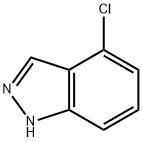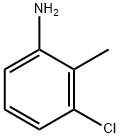Synthesis
Step A: Preparation of 4-chloro-1H-indazole: In a 250 mL round-bottomed flask equipped with a stirrer, 2-methyl-3-chloroaniline (8.4 mL, 9.95 g, 70.6 mmol), potassium acetate (8.3 g, 84.7 mmol), and chloroform (120 mL) were added in sequence. The reaction mixture was cooled to 0 °C with stirring. Subsequently, acetic anhydride (20.0 mL, 212 mmol) was added slowly and dropwise over 2 minutes to the cooled mixture. The reaction mixture was gradually warmed to 25 °C and stirred continuously at this temperature for 1 hour. After that, the reaction system was heated to 60 °C and isopentyl nitrite (18.9 mL, 141 mmol) was added. The reaction mixture was stirred at 60 °C overnight. After the reaction was completed, water (75 mL) and THF (150 mL) were added and the mixture was cooled to 0 °C. Next, lithium hydroxide (LiOH, 20.7 g, 494 mmol) was added and the reaction continued to be stirred at 0 °C for 3 hours. After addition of water (200 mL), extraction was performed with ethyl acetate (EtOAc, 300 mL, followed by 100 mL). The organic phases were combined, dried over anhydrous magnesium sulfate (MgSO4) and concentrated under reduced pressure to give 4-chloro-1H-indazole (11.07 g, 100% yield) as an orange solid. The product was confirmed by 1H NMR (400 MHz, CDCl3) and LCMS (ESI pos), 1H NMR data: δ 8.18 (d, J = 1 Hz, 1H), 7.33 (d, J = 8 Hz, 1H), 7.31 (t, J = 7 Hz, 1H), 7.17 (dd, J = 7 Hz, 1 Hz, 1H); LCMS (ESI pos) m/e 153 (M + 1).
References
[1] Patent: WO2009/42607, 2009, A1. Location in patent: Page/Page column 74
[2] Patent: WO2009/97446, 2009, A1. Location in patent: Page/Page column 70
[3] Patent: WO2012/82997, 2012, A1. Location in patent: Page/Page column 79
[4] Patent: WO2009/146406, 2009, A1. Location in patent: Page/Page column 65-66
[5] Organic Process Research and Development, 2013, vol. 17, # 1, p. 97 - 107





